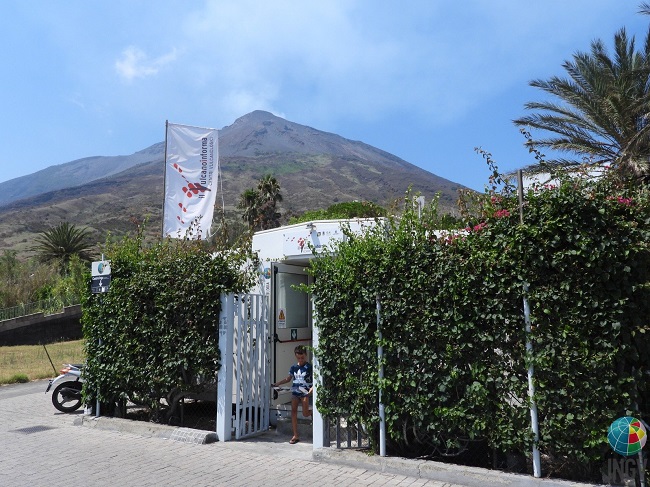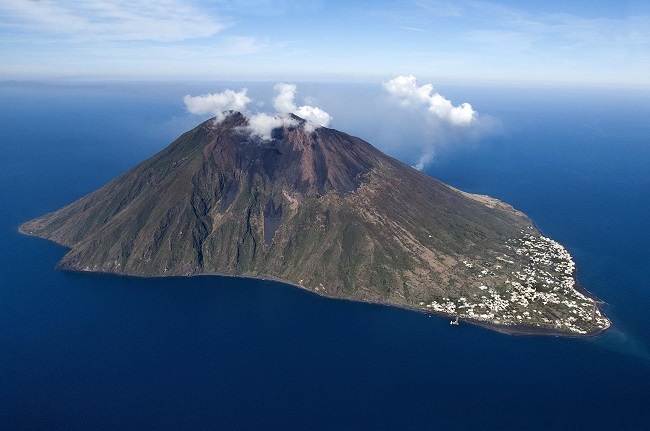By VALERIA DE PAOLA [INGV newsletter]
The Aeolian archipelago consists of seven volcanic islands: Alicudi, Filicudi, Lipari, Panarea, Salina, Stromboli, and Vulcano. Of these Islands, Stromboli is the most active volcano. To learn about its nature from “birth” to current events, we interviewed Mauro Coltelli, a volcanologist at the Osservatorio Etneo in Catania and Coordinator of Centro Monitoraggio delle Eolie (CME)
Mauro, what is the history of the Stromboli volcano?
Stromboli is the northernmost volcano of the Aeolian arc and is also the most active one.
From a geological point of view, it is linked to a process of subduction of the Ionian Plate which plunges beneath Calabria and sinks into the mantle up to over six hundred kilometers deep, releasing the fluids contained in the crust that “reactivate” the mantle above in the production of magma.
This magma is of the basaltic type, rather fluid and less viscous than that produced by the eruptions of the other Aeolian volcanoes.
Stromboli is characterized by the persistent eruptive activity of the Strombolian type. The name of this activity, typical of all the basaltic volcanoes on the planet, was coined by the geologist Giuseppe Mercalli observing that of Stromboli characterized by small explosions that throw bombs and shreds of lava into the air and resemble fireworks.
What is the age of Stromboli?
The age of the volcano is very ancient: about over a million years as regards the submarine formation of the volcanic building, while the subaerial eruptive activity that forged the emerged part was initially produced by a small adventitious cone called Strombolicchio starting around 200,000 years ago. This place today is a rock, a beautiful place from which you can observe the core of the volcanic center.
What was the activity that characterized the volcano in the most recent period?
The subaerial eruptive activity of the volcano in the last 85,000 years has been characterized by a continuous construction and destruction of the main cone.
Following a series of events, the main cone was positioned more or less where the eruptive vents are today and formed the Neo-Stromboli. The latter collapsed into the sea forming the Sciara del Fuoco, a depression where the eruptive activity is restarted. The current activity is produced by a series of vents that open onto a plateau called the crater terrace, which is what remains of the ancient crater partly collapsed into the sea.
What kind of activity can we observe today?
The present activity of Stromboli is extremely typical of basaltic volcanoes but at the same time, it is peculiar as it is persistent. This state of activity began over 1000 years ago.
The most frequent activity that we can observe is the Strombolian one, characterized by small explosions that can reach 250 meters in height. These are emissions of volcanic bombs and lapilli from multiple vents that pour out this incandescent material previously accumulated inside the volcanic conduit.
Strombolian activity is occasionally interrupted by more violent events that occur periodically with a frequency of some a year. However, with an even lower frequency, it is possible to observe extraordinary events called paroxysms; the latest took place in July and August 2019.
The explosions that occur in these cases are stronger than those of ordinary Strombolian activity, in fact, the erupted products form eruptive columns that can even reach 8-9 kilometers above sea level and fall on the low slopes of the volcano and the sea. In these cases it is possible there is a formation of pyroclastic flows that rapidly descend along the Sciara del Fuoco to the sea, flowing on the sea surface up to a couple of kilometers away.
In addition to this explosive activity, we have lava emission phenomena that can be of two types: the emission produced by the summit vents which forms small flows of a few reaching the sea, and more complex emissions, due to the intrusion of dikes inside of the Sciara del Fuoco, which produce eruptive fissures from which the magma comes out copiously for very long periods (many months). A particular case is that of the intrusion that occurred in 2003, which occurred at such a low altitude that it destabilized the Sciara del Fuoco, in particular the submerged part, which collapsed causing a tsunami.
How is the monitoring of this volcano carried out?
On the island of Stromboli, we have a fairly complex monitoring system as the type of persistent volcanic activity requires constant knowledge of the trend of the phenomenon. We have is to characterize the eruptive activity from the geochemical and geophysical parameters monitored to try to understand the changes in the volcano.
In this regard, we have installed a series of seismic sensors that measure the explosions. We are also working on the future installation of an underwater seismic cable that will go from the coast to about 1,500 meters below sea level to get information from the deepest part of the volcano. We carry out soil deformation studies with various tools, as well as the monitoring of gases emitted by the vents and the soil. By monitoring the latter, in fact, we can get an idea of the path of the magma, from the source area in the earth’s mantle to the storage area located in the volcanic building under the crater terrace up to an altitude of about 450 meters above sea level.
Finally, we have cameras that also detect the thermal band and with their images allow us to characterize the type of activity and measure the number of explosions.
What is the name of the INGV infrastructure that coordinates the monitoring of Stromboli?
The monitoring of Stromboli, as well as that of the Aeolian Islands, has been operated by INGV since its inception. In 2019, to improve our ability to operate within a complex monitoring system, the Centro di Monitoraggio delle Isole Eolie – CME was born.
The CME operates coordination between the volcanological observatory of Catania, the Osservatorio Vesuviano, and the INGV Section of Palermo which deals with the study of volcanic fluids.

Finally, what is your advice for those who want to visit the island?
Visiting an island that has a volcano characterized by ever-present activity is a unique and fascinating experience.
However, it is necessary to take into account the risks associated with the territory because Strombolian activity can be interrupted by major events so it is always good to be at a sufficient distance to take shelter in case of need.
My suggestion is to follow the instructions of the Civil Protection authorities and enjoy the wonderful landscape.





